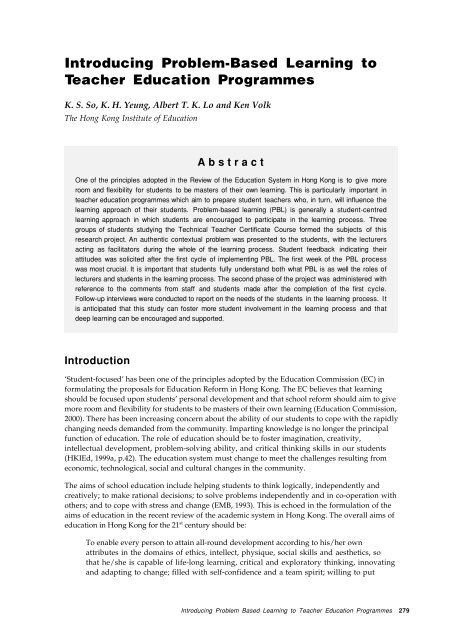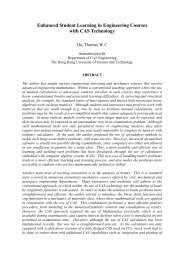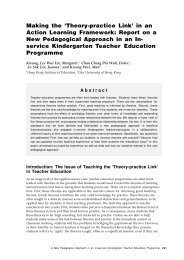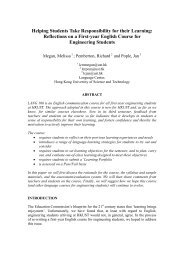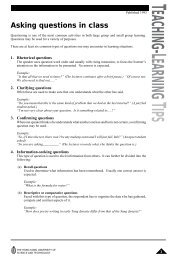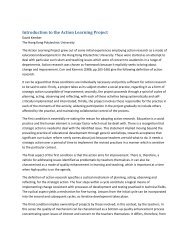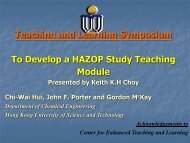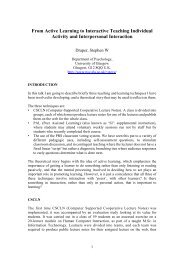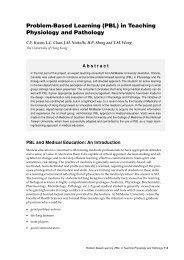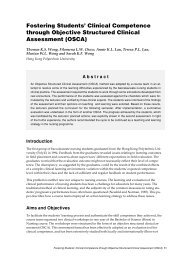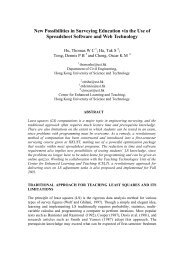Introducing Problem-Based Learning to Teacher Education ...
Introducing Problem-Based Learning to Teacher Education ...
Introducing Problem-Based Learning to Teacher Education ...
Create successful ePaper yourself
Turn your PDF publications into a flip-book with our unique Google optimized e-Paper software.
<strong>Introducing</strong> <strong>Problem</strong>-<strong>Based</strong> <strong>Learning</strong> <strong>to</strong><br />
<strong>Teacher</strong> <strong>Education</strong> Programmes<br />
K. S. So, K. H. Yeung, Albert T. K. Lo and Ken Volk<br />
The Hong Kong Institute of <strong>Education</strong><br />
A b s t r a c t<br />
One of the principles adopted in the Review of the <strong>Education</strong> System in Hong Kong is <strong>to</strong> give more<br />
room and flexibility for students <strong>to</strong> be masters of their own learning. This is particularly important in<br />
teacher education programmes which aim <strong>to</strong> prepare student teachers who, in turn, will influence the<br />
learning approach of their students. <strong>Problem</strong>-based learning (PBL) is generally a student-centred<br />
learning approach in which students are encouraged <strong>to</strong> participate in the learning process. Three<br />
groups of students studying the Technical <strong>Teacher</strong> Certificate Course formed the subjects of this<br />
research project. An authentic contextual problem was presented <strong>to</strong> the students, with the lecturers<br />
acting as facilita<strong>to</strong>rs during the whole of the learning process. Student feedback indicating their<br />
attitudes was solicited after the first cycle of implementing PBL. The first week of the PBL process<br />
was most crucial. It is important that students fully understand both what PBL is as well the roles of<br />
lecturers and students in the learning process. The second phase of the project was administered with<br />
reference <strong>to</strong> the comments from staff and students made after the completion of the first cycle.<br />
Follow-up interviews were conducted <strong>to</strong> report on the needs of the students in the learning process. It<br />
is anticipated that this study can foster more student involvement in the learning process and that<br />
deep learning can be encouraged and supported.<br />
Introduction<br />
‘Student-focused’ has been one of the principles adopted by the <strong>Education</strong> Commission (EC) in<br />
formulating the proposals for <strong>Education</strong> Reform in Hong Kong. The EC believes that learning<br />
should be focused upon students’ personal development and that school reform should aim <strong>to</strong> give<br />
more room and flexibility for students <strong>to</strong> be masters of their own learning (<strong>Education</strong> Commission,<br />
2000). There has been increasing concern about the ability of our students <strong>to</strong> cope with the rapidly<br />
changing needs demanded from the community. Imparting knowledge is no longer the principal<br />
function of education. The role of education should be <strong>to</strong> foster imagination, creativity,<br />
intellectual development, problem-solving ability, and critical thinking skills in our students<br />
(HKIEd, 1999a, p.42). The education system must change <strong>to</strong> meet the challenges resulting from<br />
economic, technological, social and cultural changes in the community.<br />
The aims of school education include helping students <strong>to</strong> think logically, independently and<br />
creatively; <strong>to</strong> make rational decisions; <strong>to</strong> solve problems independently and in co-operation with<br />
others; and <strong>to</strong> cope with stress and change (EMB, 1993). This is echoed in the formulation of the<br />
aims of education in the recent review of the academic system in Hong Kong. The overall aims of<br />
education in Hong Kong for the 21 st century should be:<br />
To enable every person <strong>to</strong> attain all-round development according <strong>to</strong> his/her own<br />
attributes in the domains of ethics, intellect, physique, social skills and aesthetics, so<br />
that he/she is capable of life-long learning, critical and explora<strong>to</strong>ry thinking, innovating<br />
and adapting <strong>to</strong> change; filled with self-confidence and a team spirit; willing <strong>to</strong> put<br />
<strong>Introducing</strong> <strong>Problem</strong> <strong>Based</strong> <strong>Learning</strong> <strong>to</strong> <strong>Teacher</strong> <strong>Education</strong> Programmes 279
forward continuing effort for the prosperity, progress, freedom and democracy of his/her<br />
society, and contribute <strong>to</strong> the future well-being of the nation and the world at large.<br />
(<strong>Education</strong> Commission, 2000, p.5)<br />
Quality <strong>Learning</strong> and Teaching<br />
In order <strong>to</strong> allow more room and flexibility for students <strong>to</strong> be masters of their own learning,<br />
students’ needs and interests should be given due consideration, as should the learning and<br />
teaching approaches used. The constructivist view of learning places emphasis on the learner in<br />
the creation of knowledge.<br />
If students are <strong>to</strong> learn desired outcomes in a reasonably effective manner, then the<br />
teacher’s fundamental task is <strong>to</strong> get students <strong>to</strong> engage in learning activities that are<br />
likely <strong>to</strong> result in their achieving those outcomes…It is helpful <strong>to</strong> remember that what<br />
the student does is actually more important in determining what is learned than what the<br />
teacher does. (Shuell, 1986, p.429).<br />
In other words, it is the learner who constructs knowledge, not the teacher who imparts it (Biggs,<br />
1991). How would the learners learn <strong>to</strong> construct knowledge How should the teachers promote<br />
appropriate learning approaches <strong>to</strong> foster this construction of knowledge Biggs (1991) and Biggs<br />
and Telfer (1987) assert that in order <strong>to</strong> encourage deep learning the teaching and learning<br />
activities should contain one or more of the following:<br />
• an appropriate motivational context;<br />
• a high degree of learner activity;<br />
• interaction with others, both peers and teachers;<br />
• a well-structured knowledge-base.<br />
In developing new teacher education programmes, the Hong Kong Institute of <strong>Education</strong> (HKIEd)<br />
firmly believes that lecturing staff should model approaches which are relevant <strong>to</strong> students’<br />
own learning contexts, and that lecturers will facilitate learning by engaging students in learning<br />
activities which encourage dialogue and collaboration, reflection, critical thinking and<br />
independence (HKIEd, 1999b, p.29). This reciprocal-teaching paradigm (Palincsar, & Brown,<br />
1984; Moore, 1991) is perceived as important in nurturing an environment for quality learning and<br />
teaching. In particular, the project described in this paper aims <strong>to</strong> study the feasibility of<br />
introducing PBL in the teacher education programmes at the HKIEd.<br />
<strong>Problem</strong>-based <strong>Learning</strong><br />
<strong>Problem</strong>-based learning (PBL) is known <strong>to</strong> have originated from the medical education curricula<br />
in North America some 30 years ago. Since then, it has received considerable attention and<br />
development in other disciplines such as law, engineering, architecture, education, business, etc.<br />
In Hong Kong, PBL was first introduced <strong>to</strong> the Department of Physiology at the University of<br />
Hong Kong in 1992/93 and subsequently <strong>to</strong> the Faculty of Medicine as recommended by the<br />
research team undertaking the studies of PBL in teaching physiology and pathology (Kwan,<br />
Chan, Nichols, Sheng, & Wong, 1997 ). The philosophy behind this learning approach fits well<br />
with the present trend in education <strong>to</strong> allow the learners <strong>to</strong> be masters of their own learning. In<br />
essence, there are five defining characteristics of PBL (Bridges, & Hallinger, 1998):<br />
• The starting point for learning is a problem.<br />
280 Teaching and <strong>Learning</strong> in the Practice Situation
• The problem is one that students are apt <strong>to</strong> encounter in their future work.<br />
• Subject matter is organised around problems rather than the disciplines.<br />
• Students assume a major responsibility for their own instruction and learning.<br />
• Most learning occurs within the context of small groups rather than lectures.<br />
The PBL introduced in this project was generally a student-centred learning approach in which<br />
team spirit was emphasised. The lecturer acted as a facilita<strong>to</strong>r during the learning process. The<br />
problems were real world issues which enabled students <strong>to</strong> contextualise their understanding<br />
within a simulated policy decision making framework.<br />
Methodology<br />
Subjects<br />
The subjects of this study were students studying the one-year full-time Technical <strong>Teacher</strong>s<br />
Certificate (TTC) Course at the HKIEd. Average class size numbered around 10 students each<br />
year during each of the three cycles in the study. These students were graduates in engineering or<br />
design fields with most at Diploma or Higher Diploma level. Some also had degree<br />
qualifications. They also had industrial experiences before enrolling on the Course.<br />
Methods<br />
PBL was introduced as the teaching and learning approach in the module ‘Current Issues in<br />
Prevocational/Technology <strong>Education</strong>'. This was new <strong>to</strong> most students as it differed considerably<br />
from the traditional lectures and seminar approach they were more accus<strong>to</strong>med <strong>to</strong>. Past<br />
experience in introducing PBL in traditional courses revealed that students always found it<br />
difficult <strong>to</strong> follow at the initial stage (So, & Yu, 1996). It is therefore important <strong>to</strong> provide a<br />
thorough description of the PBL approach and the roles of lecturer and students at the early<br />
stage of the learning process. These include introducing <strong>to</strong> students the concept of PBL, the week<br />
by week processes, the assessment scheme and the possible problems encountered.<br />
There were four components in the overall assessment:<br />
Attendance 10%<br />
Participation<br />
30% (mean of peer, self and lecturer scores)<br />
Five-minute papers 20%<br />
Report<br />
40% (lecturer assessed)<br />
The assessment of participation was based on the student’s contribution <strong>to</strong> class discussions,<br />
demonstration of research efforts, and performance in report presentation. The rationale for such<br />
weightings was <strong>to</strong> enable students <strong>to</strong> have more involvement in both the learning as well as the<br />
assessment of the module.<br />
During the learning process students were required <strong>to</strong> complete a five-minute reflection paper<br />
(Whittle, & Marsh, 1994, p.12) (see Figure I) after each PBL session. The purposes of the fiveminute<br />
reflection papers were <strong>to</strong> stimulate students’ thinking and reflections on their learning<br />
and <strong>to</strong> compare their initial expectations with the outcomes they obtained through research and<br />
group discussions.<br />
<strong>Introducing</strong> <strong>Problem</strong> <strong>Based</strong> <strong>Learning</strong> <strong>to</strong> <strong>Teacher</strong> <strong>Education</strong> Programmes 281
Figure 1: Five minute reflection papers<br />
Name: Class: Date:<br />
Five-minute Reflection Paper: Week 1<br />
What is the central problem <br />
What are the sub-problems derived from the central problem <br />
What thoughts do you have about the sub-problems before you start <strong>to</strong> do your research <br />
Write down what you think you might find out through your research activities this week <br />
What area(s) are you going <strong>to</strong> look in<strong>to</strong> this week What possible resources will you use <br />
Name: Class: Date:<br />
Five-minute Reflection Paper: Week 2<br />
Do the evidences you collected during the past week support your original thoughts <br />
Write down what you think you might find out through your research activities this week <br />
What area(s) are you going <strong>to</strong> look in<strong>to</strong> this week What possible resources will you use <br />
What further thoughts do you have about the sub-problems before you start <strong>to</strong> do your research this week <br />
Name: Class: Date:<br />
Five-minute Reflection Paper: Week 3<br />
Try <strong>to</strong> summarise the ideas about the problem you have researched in<strong>to</strong>. How has your thinking changed over<br />
the weeks <br />
_____________________________________________________________<br />
At the end of the process, each student was required <strong>to</strong> complete a questionnaire relating <strong>to</strong> the<br />
overall evaluation of their learning through PBL. Consequently, the following procedures were<br />
administered in this study:<br />
• Introduction of students <strong>to</strong> the rationale of using PBL in the Course, the concept of PBL, the<br />
week by week processes and the assessment scheme.<br />
• Arranging of students in<strong>to</strong> groups of 4-6.<br />
• Posing of the central problem <strong>to</strong> the groups.<br />
• Discussion and identification of the central problem, exploration and creation of internal<br />
ideas about the problem, splitting of the central problem in<strong>to</strong> sub-problems and distribution of<br />
the tasks among team members <strong>to</strong> conduct the investigation of a particular sub-problem.<br />
• Completion of a five-minute reflection paper after each session.<br />
• Conducting of a literature survey and search for appropriate solutions <strong>to</strong> the sub-problem,<br />
282 Teaching and <strong>Learning</strong> in the Practice Situation
oth individually or in a group ,and reporting of the finding during the PBL session.<br />
These sessions were repeated with lecturers acting as facilita<strong>to</strong>rs during the development <strong>to</strong><br />
facilitate the discussion and problem solving process. The groups were <strong>to</strong> present their solutions<br />
<strong>to</strong> the central problem <strong>to</strong> the whole class. Finally, students were required <strong>to</strong> complete an<br />
evaluation questionnaire <strong>to</strong> inform the refinements in the next cycle of implementation.<br />
Findings and Discussion<br />
First Cycle<br />
Central <strong>Problem</strong><br />
The central problem for the first cycle was related <strong>to</strong> the design of a new Graphical<br />
CommunicationLabora<strong>to</strong>ry. Students were presented with the following problem:<br />
The subject ‘Technical Drawing’ will be replaced by another subject called ‘Graphical<br />
Communication’ in the Year 2000. This will result in a corresponding change in the<br />
labora<strong>to</strong>ry layout as well as the facilities in the labora<strong>to</strong>ry. You are the panel chair of<br />
Technical Drawing in a secondary school. Your task is <strong>to</strong> design the new Graphical<br />
Communication Labora<strong>to</strong>ry, taking in<strong>to</strong> account the trend for curriculum development and<br />
the possible problems encountered during the transition period. (Technical <strong>Teacher</strong>s<br />
Certificate Course, 1997/1998, HKIEd).<br />
This problem is a major problem faced by practicing technical teachers and by graduates of the<br />
TTC Course who will be instrumental in implementing the new technical curriculum in the year<br />
2000.<br />
Sub-problems<br />
During the learning process, students discussed and managed <strong>to</strong> derive the following sub-problems<br />
<strong>to</strong> facilitate their problem-solving process:<br />
• reasons for change<br />
• room layout / modification<br />
• budget<br />
• timing<br />
• safety<br />
• construction tender<br />
• examination<br />
• facilities/equipment<br />
• upgrading the computer<br />
• software selection<br />
• teachers’ knowledge<br />
• curriculum trend<br />
• management of labora<strong>to</strong>ry<br />
<strong>Introducing</strong> <strong>Problem</strong> <strong>Based</strong> <strong>Learning</strong> <strong>to</strong> <strong>Teacher</strong> <strong>Education</strong> Programmes 283
<strong>Learning</strong> Process<br />
In order <strong>to</strong> solve the sub-problems, students identified the needs <strong>to</strong> understand the roles of the<br />
inspec<strong>to</strong>rs and school teachers, studied the criteria in choosing the curriculum, explored the<br />
constraints in room modifications, market demands and methods of assessments, etc. It was<br />
observed that students were active in searching for information from a variety of sources, such as<br />
visits <strong>to</strong> schools and the <strong>Education</strong> Department <strong>to</strong> interview teachers and inspec<strong>to</strong>rs, searching<br />
for equipment catalogues and prices, and conducting Internet and library searches.<br />
Feedback<br />
Feedback from the first cycle was obtained through the evaluation questionnaires and interviews<br />
administered at the end of the learning process. Some of the feedback is summarised in the<br />
following extracts of quotations from students:<br />
… understand the feeling and anxieties of technical teachers teaching Technical Drawing<br />
… learning <strong>to</strong>ok place through the use of Internet, discussions and management of<br />
information<br />
…understand the ‘conflict’ between inspec<strong>to</strong>rs and school teachers<br />
…my concept on Graphical Communication had been extended<br />
…visit <strong>to</strong> inspec<strong>to</strong>rate was practical and useful<br />
…group discussions helped broaden my perspective on the issue<br />
…through teamwork, I learned <strong>to</strong> develop my technique in exploration<br />
…my presentation skill was improved<br />
…I found the approach very difficult <strong>to</strong> follow in the beginning<br />
…I learned <strong>to</strong> look at problems from difference perspectives<br />
…These learning activities facilitated my participation in the learning process<br />
…I thought this was an effective learning approach<br />
…I liked the process of research<br />
The results from the evaluation questionnaire are presented in Figure 2. The students opined that<br />
they learned more or less the same as they did in a conventional lecture based course. However,<br />
they were very satisfied that the PBL approach helped them <strong>to</strong> develop communication skills<br />
effectively. In addition, they agreed that PBL encouraged them <strong>to</strong> employ a deeper approach <strong>to</strong><br />
learning than the conventional approach. When asked about the role of lecturer in the learning<br />
process, students generally expressed that the lecturer should perform the role of ‘counsellor’ <strong>to</strong><br />
provide guidance <strong>to</strong> students in tackling the problem, or ‘observer’ <strong>to</strong> observe how students<br />
approached the solving of the problem. They found it most difficult <strong>to</strong> search for relevant<br />
information, and <strong>to</strong> make sense of it, due <strong>to</strong> the fact that they were not provided with much<br />
background information.<br />
Figure 2: Evaluation Questionnaire (modified from Cawley, 1989; Ireland, 1985) The evaluation<br />
questionnaire was designed on a 5 point Likert scale - 5 meaning ‘very much’ and 1 meaning ‘not at<br />
all’<br />
284 Teaching and <strong>Learning</strong> in the Practice Situation
97/98<br />
(1 st cycle)<br />
98/99<br />
(2 nd cycle)<br />
99/00<br />
3 rd cycle)<br />
Did you find the learning approach interesting 3.8 3.4 3.8<br />
Have you enjoyed the learning process 3.9 2.8 3.7<br />
Did you find that focusing the course on real problems made the<br />
course seem more relevant <strong>to</strong> your interests<br />
4.0 3.8 4.0<br />
Did working in groups mean that you learned from each other 4.2 3.8 4.0<br />
Have you unders<strong>to</strong>od the technical materials of the course better than<br />
if it had been lectured in the conventional way, i.e. didactically<br />
Do you think you have learned as much technical materials as you<br />
would on a conventional lecture course<br />
Considering the material you have learned, do you think you have<br />
learned it more thoroughly than you would on a conventional<br />
course<br />
Has this course taken more or less time than other conventional<br />
lecture courses (In your assessment of the time taken by other<br />
courses, you should include the time you will spend on revising for<br />
the examinations.)<br />
Has this course helped you <strong>to</strong> develop communication skills<br />
effectively<br />
Has this course encouraged you more than the conventional lecture<br />
course, <strong>to</strong> use a deep approach <strong>to</strong> learning<br />
Is the level of difficulty of the problems appropriately set<br />
Would you like more problem -based learning (PBL) introduced in<strong>to</strong><br />
other modules within the curriculum <br />
3.8 3.5 3.7<br />
3.1 3.3 3.3<br />
3.9 3.8 3.7<br />
4.1 3.6 3.8<br />
4.7 3.6 3.7<br />
4.0 3.9 4.1<br />
3.3 3.1 4.0<br />
3.4 3.5 3.8<br />
Are you satisfied with the assessment methods used<br />
3.7<br />
3.1<br />
3.4<br />
Have you received sufficient direction during the learning process<br />
3.3<br />
3.0<br />
3.4<br />
Second Cycle<br />
Central <strong>Problem</strong><br />
<strong>Based</strong> on the feedback obtained from the first cycle, some background information was provided<br />
<strong>to</strong> students in the next year before they embarked on the problem-solving process. Lecturers<br />
involved were advised <strong>to</strong> give more guidance <strong>to</strong> students when it was deemed necessary and the<br />
scope of the central problem was widened <strong>to</strong> cover more areas. This was reflected in the following<br />
central problem for the second cycle.<br />
In the year 2000, a new curriculum of Graphical Communication will be implemented in<br />
prevocational and secondary technical schools in Hong Kong <strong>to</strong> replace the current<br />
Technical Drawing curriculum. <strong>Based</strong> on your previous working and teaching experiences,<br />
you are asked <strong>to</strong>:<br />
• Identify problems in terms of management, implementation, modes of teaching and<br />
learning, …etc. which will be faced by the school management team, subject panel and<br />
his team, and students themselves.<br />
• Propose strategies <strong>to</strong> resolve some of these issues.<br />
<strong>Introducing</strong> <strong>Problem</strong> <strong>Based</strong> <strong>Learning</strong> <strong>to</strong> <strong>Teacher</strong> <strong>Education</strong> Programmes 285
(Technical <strong>Teacher</strong>s Certificate Course, 1998/1999, HKIEd)<br />
Sub-problems<br />
Since this central problem covered a very wide area, the students had correspondingly derived<br />
many sub-problems. These included, among others, the aims and objectives of the new curriculum,<br />
the adaptability of the school management team, the teaching and learning methods, the<br />
impact of curriculum change on society, budgetary constraints, and implementation problems.<br />
<strong>Learning</strong> Process<br />
The learning process was similar <strong>to</strong> the first cycle in which students underwent the problem<br />
identification process, evaluated the constraints of the problem, and sought advice from relevant<br />
parties concerned. They also under<strong>to</strong>ok visits, surveys, interviews, Internet and library searches<br />
and had discussions among members. It was observed that they were rather frustrated when<br />
faced with such a huge problem and many sub-problems. The enthusiasm was low, especially<br />
during the first two weeks. The whole exercise was extended by one week <strong>to</strong> a <strong>to</strong>tal of four weeks<br />
<strong>to</strong> allow the teams more time <strong>to</strong> gather and analyse the information.<br />
Feedback<br />
The results of the evaluation questionnaires in the second cycle suggested that the students did<br />
not seem <strong>to</strong> enjoy the learning process (2.8 in a 5-point Likert scale with 5 being ‘very much’ and 1<br />
being ‘not at all’). The response in the first cycle was 3.9 for the same question. An analysis of the<br />
week-by-week process through discussions with the teams and reading the 5-minute reflection<br />
papers revealed that they spent considerable time in deriving sub-problems. They expressed<br />
during the interviews that the process of deriving sub-problem from the central problem caused a<br />
lot of confusion. The following are examples of some of their comments on the learning approach.<br />
… through PBL, I learned <strong>to</strong> analyse problems from different perspectives<br />
… explored the main concept through different channels<br />
… found it difficult <strong>to</strong> follow at the beginning<br />
… There were <strong>to</strong>o many sub-problems derived from the central problem … helped<br />
strengthen the learning of subject knowledge<br />
… the workload of this kind of PBL was heavy<br />
… time was limited, so it is impossible <strong>to</strong> look in<strong>to</strong> every details<br />
… this learning approach was constructive and worth implementing<br />
… facilitated co-operation and sharing of experiences among colleagues<br />
… established linkages with the professional community<br />
… was aware of the importance of teacher retraining in this curriculum change<br />
… good <strong>to</strong> have the chances <strong>to</strong> meet difference groups of people during the learning process<br />
The general comment from the students indicated that the central problem was <strong>to</strong>o difficult for<br />
them. In fact, one of the biggest challenges in using PBL is <strong>to</strong> create ill-defined problem scenarios<br />
that are relevant and appropriate. If the problems presented are <strong>to</strong>o clearly defined, students<br />
may lose the opportunity <strong>to</strong> engage in problem-finding or the problem may lose some of the<br />
flavour of reality (Bridges, & Hallinger, 1995). The implementation of the second cycle<br />
286 Teaching and <strong>Learning</strong> in the Practice Situation
suggested that the design of the central problem must be well balanced and thought through.<br />
This is also the difficulty faced by many PBL programmes.<br />
Third Cycle<br />
Central <strong>Problem</strong><br />
In this last cycle, the central problem was carefully designed <strong>to</strong> focus mainly on the learning and<br />
teaching aspects of the new technical curriculum.<br />
The current prevocational and secondary technical curriculum is undergoing extensive<br />
reviews. Some outdated subjects will be removed while new technology/business subjects<br />
will be introduced in the year 2000. Consequent <strong>to</strong> this move, the need <strong>to</strong> review the<br />
teaching approaches with reference <strong>to</strong> the teaching resources available is apparent. You<br />
are the panel chair of technical subjects in a prevocational or technical school. Your brief<br />
is <strong>to</strong> review the impact of such change on the learning and teaching quality of<br />
technology/business subjects and <strong>to</strong> make recommendations on the teaching approaches<br />
appropriate <strong>to</strong> the new technical curriculum. (Technical <strong>Teacher</strong>s Certificate Course<br />
1999/2000, HKIEd)<br />
Sub-problems<br />
The sub-problems were more focused in this round. They basically centred around issues relating<br />
<strong>to</strong> curriculum, pedagogy and resources and the impacts of the curriculum changes upon teachers<br />
and students. The sub-problems derived by the students included the following.<br />
• Demands for teacher retraining as a result of the curriculum change;<br />
• Need for replacing the old equipment and facilities;<br />
• Comparison of traditional and new teaching approaches;<br />
• Impacts of new teaching approaches on practicing teachers and students;<br />
• Issues relating <strong>to</strong> curriculum, pedagogy and resources …;<br />
• Changes in subject knowledge and teaching aids;<br />
• Any change in the aims of technology education;<br />
• Limitations of the current teaching approaches.<br />
<strong>Learning</strong> Process<br />
Students managed <strong>to</strong> present their solutions <strong>to</strong> the problem in three weeks. Their learning<br />
approaches were similar <strong>to</strong> the previous two groups. There was not much frustration<br />
demonstrated during the process. This might be attributed <strong>to</strong> the clear focus of the central<br />
problem. Some students expressed that they initially viewed the problem in a rather abstract<br />
way. This perception had, however, gradually becoming more concrete as they gathered more<br />
information about the curriculum change.<br />
Feedback<br />
Most students believed that the level of difficulties of the problem was appropriate (4.0 in a 5-<br />
point scale). They enjoyed the learning process (3.7 as compared <strong>to</strong> 2.8 in the second cycle), and<br />
they generally supported the introduction of PBL in<strong>to</strong> other modules within the TTC curriculum.<br />
Some of their comments are summarised below.<br />
<strong>Introducing</strong> <strong>Problem</strong> <strong>Based</strong> <strong>Learning</strong> <strong>to</strong> <strong>Teacher</strong> <strong>Education</strong> Programmes 287
…Learned <strong>to</strong> analyse problem<br />
…Very time consuming <strong>to</strong> gather relevant information<br />
…This was a new but useful learning approach<br />
…It facilitated active learning<br />
…A student-centred learning approach<br />
…Difficulty in the distribution of labour<br />
…The approach was suitable for technical subjects<br />
…Should preferably be less demanding in the early stage<br />
…Not just suitable for school education but also a good approach for life-long education<br />
…Solved the problem from difference perspectives<br />
…Lacked of prior knowledge, difficult <strong>to</strong> follow<br />
With reference <strong>to</strong> the experiences gained from the first two cycles such as allocating sufficient<br />
time <strong>to</strong> tackle the problem, ensuring the appropriateness of the level of difficulty of the central<br />
problem, and defining the roles of lecturer and students, the implementation of this third cycle<br />
received encouraging comments from students. At the interviews, some students expressed that<br />
the PBL approach was a very good learning method if the problem was designed in accordance<br />
with students’ ability. It would also facilitate students <strong>to</strong> be more proactive in the problemsolving<br />
process.<br />
Conclusions<br />
The three cycles of introducing PBL in<strong>to</strong> the teaching of a module in the Technical <strong>Teacher</strong>s<br />
Certificate Course has been a rewarding experience for the research team. There were times<br />
when students were rather frustrated. The lecturer, seemingly, could have saved time and set the<br />
group on the right track by telling them what <strong>to</strong> do. However, most groups found themselves back<br />
on track by their own self-assessment and problem- solving (Bridges, & Hallinger, 1995, p.57).<br />
Our findings support Bridges and Hallinger because our attempts <strong>to</strong> shortcut the learning process<br />
through such interventions often ended up leading students on indirect routes that were less<br />
productive than if we let them work through problems on their own.<br />
This study reinforces our belief that getting students <strong>to</strong> be involved and <strong>to</strong> take charge of their<br />
own learning is fundamental <strong>to</strong> ensuring quality learning and teaching. The HKIEd has<br />
recommended PBL as one of the methods of teaching and learning in all the new programmes. It is<br />
anticipated that this initiative would allow more room and flexibility for student teachers,<br />
that they would be capable of critical and reflective thinking, life-long learning, innovating and<br />
adapting <strong>to</strong> change, and filled with self-confidence and a team spirit (<strong>Education</strong> Commission,<br />
2000). More importantly, these student teachers will in turn influence their students in promoting<br />
such spirit when they enter the teaching profession.<br />
Acknowledgements<br />
We would like <strong>to</strong> express our sincere thanks <strong>to</strong> the Action <strong>Learning</strong> Project Fund of the University<br />
Grants Committee for providing financial support <strong>to</strong> conduct this project. We are indebted <strong>to</strong> the<br />
288 Teaching and <strong>Learning</strong> in the Practice Situation
students on the Technical <strong>Teacher</strong>s Certificate Course for their eagerness <strong>to</strong> experience new<br />
learning and teaching approach. Their enthusiasm was an important fac<strong>to</strong>r contributing <strong>to</strong> the<br />
success of this project.<br />
References<br />
Biggs, J.B., & Telfer, R. (1987). The process of learning. Sydney: Prentice Hall.<br />
Biggs, J.B. (1991). Introduction and overview. In J.B. Biggs, (Ed.), Teaching for learning: The view<br />
from cognitive psychology. Vic<strong>to</strong>ria: Australian Council for <strong>Education</strong>al Research Ltd.<br />
Biggs, J.B.(1991). Good learning: what is it How can it be fostered In J.B. Biggs, (Ed.), Teaching<br />
for learning: The view from cognitive psychology. Vic<strong>to</strong>ria: Australian Council for<br />
<strong>Education</strong>al Research Ltd.<br />
Bridges, E.M., & Hallinger, P. (1995). Implementing problem-based learning in leadership<br />
development. Eugene, OR: ERIC Clearinghouse on <strong>Education</strong> Management.<br />
Bridges, E.M., & Hallinger, P. (1998). <strong>Problem</strong>-based learning in medical and managerial<br />
education. In R. Fogarty, (Ed.), <strong>Problem</strong> based learning - a collection of articles. USA:<br />
SkyLight Training and Publishing, Inc.<br />
Cawley, P. (1989). The introduction of a problem-based option in<strong>to</strong> a conventional engineering<br />
degree course. Studies in Higher <strong>Education</strong>, 14, 83-95.<br />
<strong>Education</strong> & Manpower Branch (1993). School education in Hong Kong: A statement of aims. Hong<br />
Kong: Government Printers.<br />
<strong>Education</strong> Commission (2000). Review of <strong>Education</strong> System: Reform proposals – excel and grow.<br />
Hong Kong: Government Printers.<br />
Ireland, J. (1985). <strong>Problem</strong>-based learning in environmental health. In D. Boud, (Ed.), <strong>Problem</strong>based<br />
learning in education for the profession. Australia: HERDSA.<br />
Kwan, C.Y., Chan, C.L. Nichols, J.M.Sheng, H.P., & Wong, T.M. (1997). <strong>Problem</strong>-based learning<br />
(PBL) in teaching physiology and pathology. In D. Kember, B-h Lam, L. Yan, J.C.K. Yum,<br />
& S.B. Liu (Eds.), Case studies of improving teaching and learning from the Aaction<br />
<strong>Learning</strong> Project. Hong Kong: Action <strong>Learning</strong> Project.<br />
Palincsar, A.M., & Brown, A.L. (1984). Reciprocal teaching of comprehension fostering and<br />
moni<strong>to</strong>ring activities. Cognition and Instruction, 1, 117-175.<br />
Shuell, T.J. (1986). Cognitive conceptions of learning. Review of <strong>Education</strong>al Research, 56, 411-<br />
436.<br />
So, K.S., & Yu, W.M.C. (1996). <strong>Problem</strong> based learning in business education. Proceedings of<br />
Conference on Business <strong>Education</strong> in Hong Kong. University of Hong Kong: Faculty of<br />
<strong>Education</strong>.<br />
The Hong Kong Institute of <strong>Education</strong> (1999a). Four-year full-time Bachelor of <strong>Education</strong><br />
(Honours) (Secondary) programme: Part I: General information (p.42). Hong Kong: Author<br />
The Hong Kong Institute of <strong>Education</strong> (1999b). Two-year part-time Postgraduate Diploma in<br />
<strong>Education</strong> (Secondary) programme: Part I: General information (p.29). Hong Kong: Hong<br />
Kong Institute of <strong>Education</strong><br />
Whittle, J. & Marsh, J. (1994). Teaching in higher education – MEd. course materials. (p.12).<br />
University of Hong Kong: Faculty of <strong>Education</strong>.<br />
<strong>Introducing</strong> <strong>Problem</strong> <strong>Based</strong> <strong>Learning</strong> <strong>to</strong> <strong>Teacher</strong> <strong>Education</strong> Programmes 289


